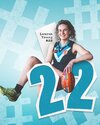RussellEbertHandball
Flick pass expert
That was her write up on the AFL website article below in August, about the All Oz team from this year's U/18 national championships. All 23 players get a write up.AFL Talent Ambassador Kevin Sheehan said:
“Strong and aggressive player who excelled as a forward but can play back or midfield. Attacks the ball fearlessly and is almost unbeatable one-on-one with her overhead marking a real feature of her play. Kicked five goals to blow the game apart versus Victoria Metro and finished up averaging three goals across three matches, along with 17.3 disposals, seven marks and three tackles to again be a dominant force after winning the best and fairest award in this competition two years ago when in her 16th year.”
Port Adelaide welcomes Lauren Young
There were 8 SA girls who made the ALL Oz team so we might draft/sign 4 or 5 of them. It says 12 of the 23 girls that made the team were bottom-age players, so they aren't available for the 2023 draft. I think 3 of the 12 are from SA.
The championships aren't full play everyone or two divisions, as teams only play 3 games but there are 6 teams SA, WA, Qld, Vic Metro, Vic Country and the Allies.
SA has been undefeated the last 2 years.
Pretty amazing to think this has happened given how poor a state women's footy in SA was when an AFLW comp was suggested in mid to late 2015, and the SA women played in Div 2 at national championships, for many years and weren't always the winner of Div 2 and SA was in Div 2 of the U/18 national championships for several years, before the 2 divisions were amalgamated in 2019.
Shows how much demand was there under the surface from girls in SA to play footy, but the SANFL and its clubs were never proactive enough before 2017, to do much about it.
2021 was an U/19 championships to give the girls who missed out because of Covid in 2020 the chance to play in the national championships and get drafted. That's why it says in Lauren's profile that, she made the U/19 All Oz team and not the U/18 team.
2023 AFL National Championships U18 Girls All-Australian Team and B&F announced
The AFL has today announced the 2023 AFL National Championships U18 Girls All-Australian Team and best and fairest award.






